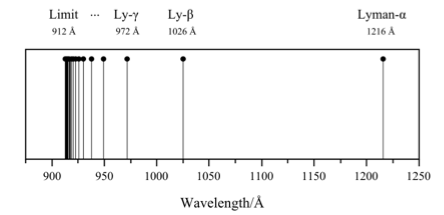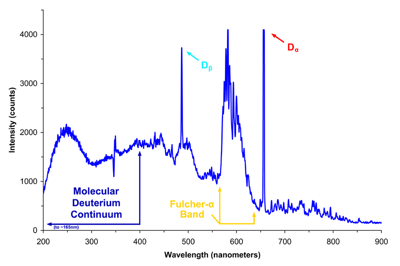Quasi-stellar objects (QSOs) or quasars are very energetic and ultraluminous objects located at the centers of distant galaxies [1]. In the optical and radio spectrum they show up as point source similar to stars instead of extended source like galaxies, this happens due to their very high luminosity which outshines any other light source in the host galaxy including all the stars [2].
The energy spectra of quasars indicate very large redshift, typically in the range z = 0.2-2.5 but a few reach beyond z = 6, which is an effect due to the expansion of the universe. The redshift parameter z can be defined as, z = (λ - λ0)/ λ0, where λ0 is the wavelength at rest of a spectral line and λ is the observed wavelength [2]. Applying Hubble’s law it can be shown that the greater the redshift of a quasar the farther away it is from earth. The nearest detected quasar is about 250 Mpc from earth and the farthest one being 8600 Mpc [1] [3]. The fact that quasars are at immense distances from earth and are yet visible indicates that they are very luminous objects. For example, quasar 3C 273 has a luminosity of 2.5 X 1040 watts, which is equivalent to 25 trillion Suns (Sun’s luminosity is 3.9 X 1026 watts). The luminosity of quasars can be calculated from its apparent brightness using the inverse square law, b = L/(4πd2), where ‘b’ is the apparent brightness of the source, ‘L’ is luminosity and ‘d’ is distance [1].
The luminosity of quasars varies in time scales ranging from a year or few months to merely few hours. This change is even more rapid in the X-ray than in optical spectrum. The rapid variability in luminosity sets an upper limit on the volume of quasars. This implies that quasars produce and emit their energy from a very small region [1]. Emission of such huge amount of energy from a small region cannot be powered by nuclear fusion, which converts about 0.5% of mass of an object into energy, like in stars. Quasars are powered by supermassive black holes at their centers, which convert about 10% of mass of an object into energy [4]. In terms of size, quasars can be 10–10,000 times the Schwarzschild radius of the black hole [1]. As matter in the form of dust and gas clouds accelerate towards the black hole, the immense gravitational gradient causes intense heating due to friction. The gas clouds form a circular orbit around the black hole and as these gas clouds are of finite size and, since they move in Keplerian orbit, the inner parts of the gas clouds will orbit faster than the outer parts creating friction between neighboring clouds at different radii and thus losing energy in the form of heat. Consequently the inner parts of the gas clouds will fall further inwards to even smaller orbits and the process will continue until a complete accretion disc is formed around the black hole [5].
Another phenomenon that can be observed in an AGN is the ejection of mass, in the form of jets, in the directions perpendicular to the accretion disc at nearly the speed of light. One suggested mechanism to explain this is that at distances very close to the event horizon of the black hole the accretion disc thickens and forms a pair of opposing funnels. The intense radiation pressure within these funnels causes the matter to accelerate and eject along the rotational axis of the accretion disc. But this model alone fails to explain the formation of the observed jets. Another variant of this model suggests that the magnetic field of the accretion disc plays a vital role in the ejection of jets but yet does not provide a full explanation for the formation of these jets
The presence of dust in and around the AGN creates another observational challenge for researchers. Interstellar dust has two key effects on light passing through it:
All quasars have bright emission lines in their optical spectrum. These spectral lines are used to calculate their redshift. Among the strongest emission lines in a quasar’s spectrum are hydrogen’s first Lyman Series (Lyman Alpha) line at 1216 Å and the second Balmer Line (hydrogen Beta) at 4861 Å, shown in Figure 1.2 and Figure 1.3. Many, but not necessarily all, quasars have absorption lines in their spectra. Quasars having emission line redshifts of less than 2.2 typically do not have absorption lines, but those with greater redshifts have strong absorption lines. These lines are usually very narrow compared with the emission lines. In general the absorption line redshifts are less than the redshift for the emission lines and also the absorption lines sometimes show more than one redshift [6].

Figure 1.2 : First series of Hydrogen emission lines also known as Lyman series[7].

Figure 1.3 : Two of the Balmer lines (α and β) are visible in this emission spectrum of a deuterium lamp [8].
The type of intrinsic absorptions in quasars and other AGNs has important implications for structural models of the quasar “central engine”. Broad absorption line quasars (BALQSOs) are thought to account for between 10% and 30% of quasars. Broad absorptions are caused by gas excreting at high velocities from quasars. It has been suggested that some or all BALQSOs may be a single class of quasars in a different stage of their life cycle. Other authors suggest that the difference between BALQSOs and standard ones arise merely because they are viewed at a different angle. BALQSOs generally have UV to soft X-ray flux ratios 10-30 times smaller than unabsorbed quasars, though if BALQSOs are corrected for intrinsic absorption, their UV to soft X-ray flux ratio is typical of normal quasars.
Three sources of material can cause absorption in the spectrum of a quasar:
1. Intrinsic: Produced by the AGN itself,
2. Host: Produced by materials in the quasar’s host galaxy unrelated to the AGN.
3. Intervening: Absorbing material along the line of sight but not physically related to the AGN or host galaxy.
Broader and higher-velocity absorption lines are more likely to be intrinsic, since only the AGN can accelerate matter to such velocities and velocity widths observed (both often ≥ 10000 km s−1) [7].
A more detailed discussion about how quasars can be identified and classified will be discussed in the upcoming chapter.

